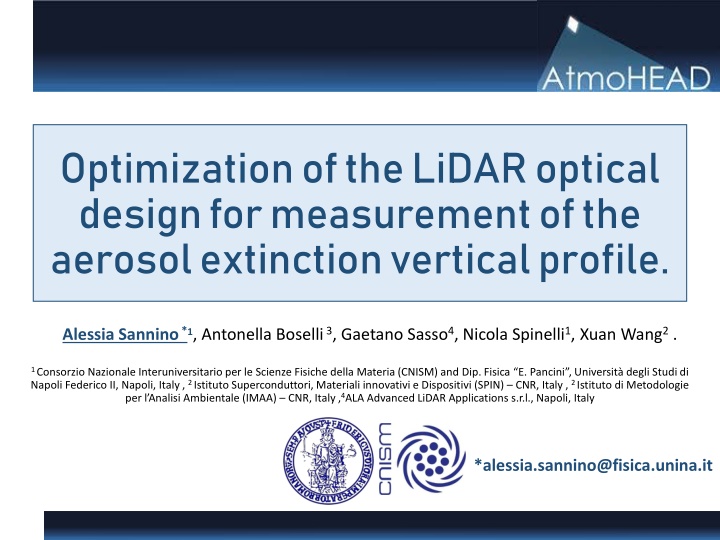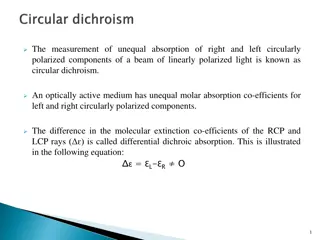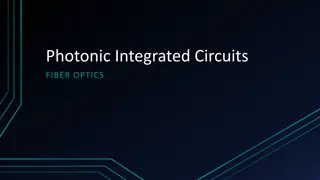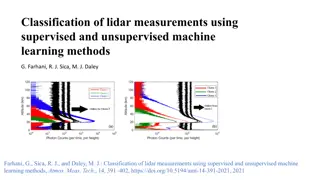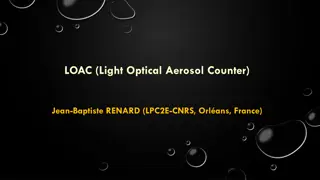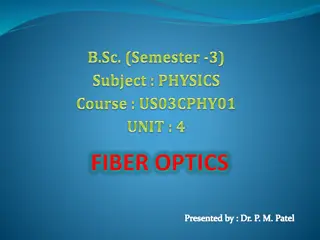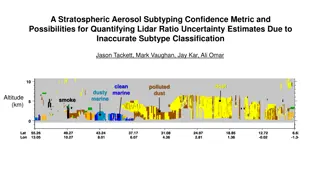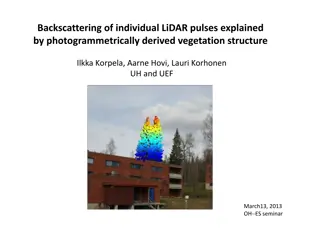Optimization of LiDAR Optical Design for Aerosol Extinction Measurement
This study focuses on optimizing the LiDAR optical design for accurate measurement of aerosol extinction vertical profiles. The research, conducted by Alessia Sannino and team, aims to enhance the precision and reliability of LiDAR technology in environmental monitoring applications.
Download Presentation

Please find below an Image/Link to download the presentation.
The content on the website is provided AS IS for your information and personal use only. It may not be sold, licensed, or shared on other websites without obtaining consent from the author.If you encounter any issues during the download, it is possible that the publisher has removed the file from their server.
You are allowed to download the files provided on this website for personal or commercial use, subject to the condition that they are used lawfully. All files are the property of their respective owners.
The content on the website is provided AS IS for your information and personal use only. It may not be sold, licensed, or shared on other websites without obtaining consent from the author.
E N D
Presentation Transcript
Optimization of the LiDAR optical design for measurement of the aerosol extinction vertical profile. Alessia Sannino *1, Antonella Boselli 3, Gaetano Sasso4, Nicola Spinelli1, Xuan Wang2 . 1 Consorzio Nazionale Interuniversitario per le Scienze Fisiche della Materia (CNISM) and Dip. Fisica E. Pancini , Universit degli Studi di Napoli Federico II, Napoli, Italy , 2 Istituto Superconduttori, Materiali innovativi e Dispositivi (SPIN) CNR, Italy , 2 Istituto di Metodologie per l Analisi Ambientale (IMAA) CNR, Italy ,4ALA Advanced LiDAR Applications s.r.l., Napoli, Italy *alessia.sannino@fisica.unina.it
OVERVIEW OVERVIEW Why low range atmosphere information are so important LiDAR capabilities Our proposal Results and Conclusions alessia.sannino@fisica.unina.it 25 September, Anacapri
INTRODUCTION INTRODUCTION Radius (range covered:107) Anthropogenic Source ARMOSPHERIC ARMOSPHERIC PARTICLES PARTICLES MOLECULAS AEROSOL Shape p, T (r) Geographical source Natural Source Generation processes alessia.sannino@fisica.unina.it 25 September, Anacapri
INTRODUCTION INTRODUCTION Lidar Equation: Extinction coeff. Backscattering coeff. Overlap Function A. L. Oramas BIAXIAL COAXIAL alessia.sannino@fisica.unina.it alessia.sannino@fisica.unina.it 25 September, Capri 25 September, Anacapri
PERFORMING LIDAR PROTOTYPE FEATURES PERFORMING LIDAR PROTOTYPE FEATURES Output laser wavelength 355nm Repetition Frequency 2kHz Telescope 200mm Cassegrain F/n 2.5 Channels 355S, 355p, 386 Weight 35kg alessia.sannino@fisica.unina.it alessia.sannino@fisica.unina.it 25 September, Capri 25 September, Anacapri
RESULT I RESULT I Raman Overlap (res.60m) (res.60m) Horizontal Overlap (res.15m) (res.15m) compared with Simulated Overlap function (res 15m) (res 15m) 120m alessia.sannino@fisica.unina.it alessia.sannino@fisica.unina.it 25 September, Capri 25 September, Anacapri
RESULT II RESULT II Comparison of the signals measured Comparison of the signals measured with different with different Lidar Lidar systems systems MALIAis - the fixed system based at the Physics Department FedericoII diNapoli - ActrisandEARLINETnetwork. - 3betaand2alpha - 2depolarizationchannels - telescopefieldofviewat1.33mrad - 300 mm Newtonian telescope - Nd:YAG @1064nm, 532nm and 355nm MALIA MALIA @R386 nm @R386 nm of University alessia.sannino@fisica.unina.it alessia.sannino@fisica.unina.it 25 September, Capri 25 September, Anacapri
RESULT III RESULT III Comparison of the signals measured with different Lidar systems - ACTRISfacilities - Cassegraintelescope - 200mm/48mm - Fieldofview:2.5mrad alessia.sannino@fisica.unina.it alessia.sannino@fisica.unina.it 25 September, Capri 25 September, Anacapri
SUMMARY AND CONCLUSION SUMMARY AND CONCLUSION A study on several optical assembly has been conducted in order to find the best configuration system which guaranteed a good signal started from the lowest possible altitude. The optimized optical system has been obtained with a choice on F- number of 2.5. This optimized optical system has been realized for a compact Lidar system which allowed to test both with simulated and measured results its Overlap function. The test results shown an Overlap function of a few tens on meters (~120m). alessia.sannino@fisica.unina.it alessia.sannino@fisica.unina.it 25 September, Capri 25 September, Anacapri
Thanks! alessia.sannino@fisica.unina.it
RESULT III RESULT III Comparison of the signals measured with different Lidar systems - ACTRISfacilities - Cassegraintelescope - 200mm/48mm - Fieldofview:2.5mrad alessia.sannino@fisica.unina.it alessia.sannino@fisica.unina.it 25 September, Capri 25 September, Anacapri
